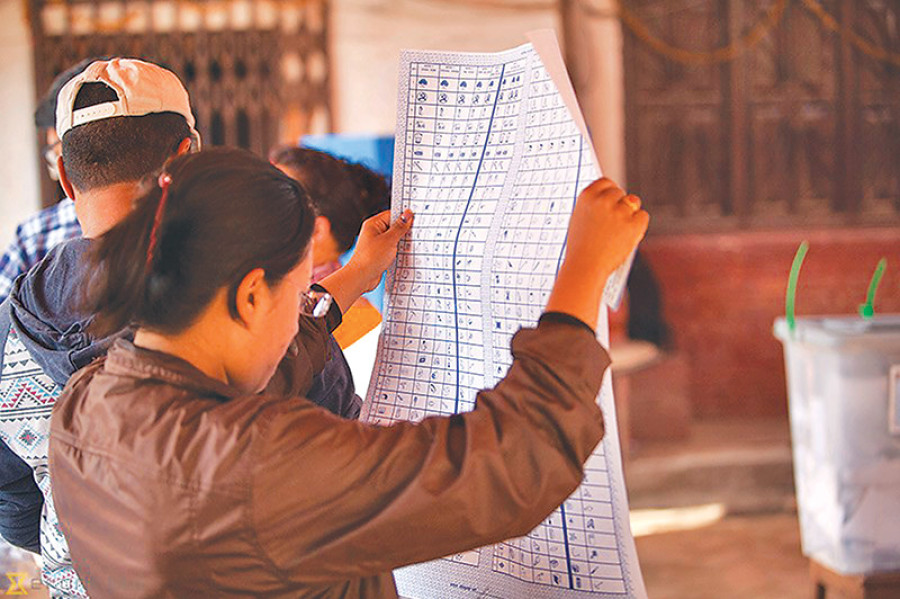Opinion
The baffled voters
Effective voter education programmes are necessary to reduce the number of invalid ballots
Umesh Raj Regmi
The recently concluded first phase of local elections have pointed to a marked need for voter education. The Election Commission of Nepal (ECN) has recognised that it is urgent to educate voters to ensure free, fair and credible elections. Making potential voters and stakeholders aware of their voting rights, and getting them to cast their votes properly and confidently is a continuous process. Much effort has been made to convince people to go cast their votes, but little has been done to make sure that they mark the ballot paper correctly. Consequently, an unexpectedly large number of invalid votes were found even in metropolitan areas.
During the last local election, voters appeared to be most confused by the way they had to choose their ward members. A single symbol has been assigned to one candidate and a double symbol to another candidate. There is no such problem with regard to independent candidates who each have their own separate symbols.
Similarly, some voters had marked the election symbol of non-existent candidates in constituencies where parties had agreed to give up posts to each other and not file nominations. The large size of the ballot paper and bewildering number of columns is certain to confuse voters during the second phase of local elections. Hence, electoral education is vital to minimise the number of invalid votes.
Many obstacles
A brief voter education programme was held at the voting centre when voters received their identity cards. Election volunteers also conducted voter education activities. But model voting programmes were very limited and procedural. It should also be noted that this type of election with a large number of candidates was something new for the ECN too. Confusion over whether the election would be held or not until one week before voting day meant that there was little focus on voter education. There was little time to hold voter outreach and education programmes during the first phase of local elections.
Likewise, party leaders and cadres concentrated solely on trying to get their candidates elected, and were not much interested in teaching voters how to mark the ballot papers correctly. At the same time, voters themselves did not show much interest in trying to find out how they would have to mark the ballot papers. Also, many educated people did not go to cast their votes after being fed up by two decades of political instability.
In a bid to promote electoral education across the country, the ECN has established the Electoral Education and Information Centre (EEIC) on its premises. The EEIC has a mini election museum, mini theatre, interactive room and mock polling booth. Mostly secondary school students visit the centre for electoral education. There are a few regional level EEICs in the country. In the same way, a mobile EEIC is being operated to provide electoral education in remote places. The ECN has also been spreading voter education through radio, television and print media besides voter education volunteers across the country.
But numerous problems have hindered voter education efforts. They are the lack of fixed dates for periodic elections, party and government dominance over the schedule, and hyperactivity during election season. Constituencies with a higher illiteracy rate usually have a higher number of invalid votes. So, voter education should be designed for and focused on constituencies having a large number of illiterate voters. Electoral education needs to be given top priority to reduce the number of invalid votes in future elections. Potential and registered voters should be urged to make proper use of their voting rights.
A vibrant democracy
The ECN has the primary responsibility to disseminate voter education regularly. In addition, social organisations, civil society and youth, teacher and student organisations in different parts of the country can help to educate the people. More effective messages should be broadcast over the electronic media. Popular social networks can be used to promote voter education. Door-to-door voter education programmes will produce better results because people can put their questions about the election, candidates and method of voting to the educators.
Public opinion should be collected before fixing the size and shape of the ballot paper and the number of columns. Matter related to election education in the school curriculum should be updated and improved. The government should also explore the possibility of implementing an electronic voting system by launching it in limited places. This would help minimise voting errors, delayed counting and huge paper consumption during elections.
While political leaders and social activists need to think about voter education, it is also the responsiblity of the voters to step out of their houses to cast their votes to the candidate of their choice. Our votes make democracy vibrant, and democracy is the way to prosperity, development and human rights.
Regmi is associated with the Nepal Youth Foundation




 12.12°C Kathmandu
12.12°C Kathmandu









%20(1).jpg&w=300&height=200)

